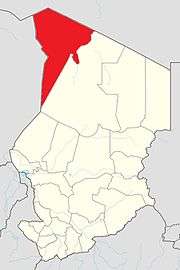Tibesti Region
Tibesti Region (Arabic: مقاطعة تيبستي) is a region of Chad, located in far northwest of the country. Its capital is Bardaï. It was created in 2008 when the former Borkou-Ennedi-Tibesti Region was split into three, with the Tibesti Department becoming the Tibesti Region. The region is named for the Tibesti Mountains, one of the most prominent mountain chains in the Sahara Desert.
Tibesti تيبستي | |
|---|---|
 Map of Chad showing Tibesti. | |
| Country | Chad |
| Departments | 2 |
| Sub-prefectures | 7 |
| Region | 2008 |
| Capital | Bardaï |
| Population (2009)[1] | |
| • Total | 25,483 |
| The 2009 census figure is an official estimate.[1] | |
History
Ancient
The rock paintings and engravings in Tibesti bear witness to an ancient civilization from 25,000 B.C. There are rock engravings in the area of Zouar, featuring, among others, cows eating fresh grass, attesting to the wet past of the Sahara. The area has historically been mainly inhabited by the Toubou people.
Age of Colonisation
In 1869 Gustav Nachtigal was sent by German Chancellor Otto von Bismarck to contact the Sultan of Bornu, and was the first European to travel the Tibesti region from Zouar to Bardaï.[2] Condemned by the traditional assembly of the Toubou to capital punishment for espionage, he appealed, but this was rejected. He was only released upon the intervention of Maï Arami Tetimi. Upon his return to Germany he published the book Sahara and the Sudan detailing his experiences.
The capital, Bardaï, was invaded by the Ottoman Empire in 1908, and by 1911 they had 60 men and 6 cannons in the town.[3]
The area fell under French rule during the Scramble for Africa in the late 19th century. Prior to 1931 much of the region belonged to what is now Niger as part of the French West Africa colony.[4]
First Chadian Civil War
Claustre Affair
in 1974, during the First Chadian Civil War, rebels led by Toubou nationalist Hissène Habré captured French archaeologist Françoise Claustre, Marc Combe (also French), an assistant to Mrs. Claustre's husband, and Christoph Staewen, a German physician. Stray bullets killed Staewen's wife. The trio were captured near Bardaï in the desert of the Tibesti Region. Combe later escaped and Staewen was released after a ransom was paid by the German government.[5] Combe would later write a book about his experiences, Otage au Tibesti.[5]
Rebels also established a radio station in Bardaï called "Voice of the Liberation of Chad", also known as Radio Free Bardaï.[6] An opposition leader, Goukouni Oueddei, established a base in the Tibesti region in the early 1980s with Libyan military backing.[7] In December, 1986, Habré attacked the Libyans in the Tibesti region around Bardaï.[8]
Geography
The region borders Libya to the north, Borkou Region to the east, and Niger to the west. The most northerly of Chad's regions, it is sparsely populated, being part of the Sahara Desert. It contains parts of the Tibesti Mountains, and also part of the Erg of Bilma, a vast area of sand dunes in the centre of the desert. The region's northern border lies within the Aouzou Strip, historically a point of dispute between Chad and Libya.[11]
Demographics
The region had a population of 25,483 at the time of the 2009 Chadian census.[1] The main ethnolinguistic group is the Tedaga Toubou.[13]
Subdivisions
The region of Tibesti is divided into two departments:
| Department | Capital | Sub-prefectures |
|---|---|---|
| Tibesti Est | Bardaï | Bardaï, Zoumri, Aouzou, Yebbibou |
| Tibesti Ouest | Zouar | Zouar, Wour, Goubonne |
References
- DEUXIEME RECENSEMENT GENERAL DE LA POPULATION ET DE L’HABITAT: RESULTATS GLOBAUX DEFINITIFS (PDF) (Report). INSEED. March 2012. p. 24. Retrieved 10 March 2017.
- Fisher, Humphrey J. (January 2001). Slavery in the History of Muslim Black Africa. C. Hurst & Co. Publishers. p. 344. ISBN 978-1-85065-524-4.
- 1937-, Wright, John (1989). Libya, Chad, and the Central Sahara. Hurst. ISBN 9781850650508. OCLC 22001923.CS1 maint: numeric names: authors list (link)
- International Boundary Study No. 73 – Chad-Niger Boundary (PDF), 1 August 1966, retrieved 5 October 2019
- Hanhimäki, Jussi M.; Blumenau, Bernhard (2013). An International History of Terrorism: Western and Non-Western Experiences. Routledge. p. 200. ISBN 978-1-136-20279-7.
- 1968-, Toïngar, Ésaïe (2006). A teenager in the Chad Civil War : a memoir of survival, 1982-1986. McFarland. ISBN 9780786424030. OCLC 67361640.CS1 maint: numeric names: authors list (link)
- 1969-, McKenna, Amy (2011). The history of western Africa. Britannica Educational Pub. in association with Rosen Educational Services. ISBN 9781615303991. OCLC 694786807.CS1 maint: numeric names: authors list (link)
- Guy., Arnold (2009). The A to Z of civil wars in Africa. Scarecrow Press. ISBN 9780810868854. OCLC 815276695.
- BBC - Chad gold mine collapse leaves about 30 people dead, 26 September 2019
- Al Jazeera - Many feared dead in Chad gold mine collapse: Minister, 26 September 2019
- Geoffrey Leslie Simons, Libya and the West: from independence to Lockerbie, Centre for Libyan Studies (Oxford, England). Pg. 57
- "TCHAD: REGION du TIBESTI (Juin 2010)" (PDF). UNOCHA. Retrieved 4 October 2019.
- "Languages of Chad". Ethnologue. Retrieved 27 September 2019.